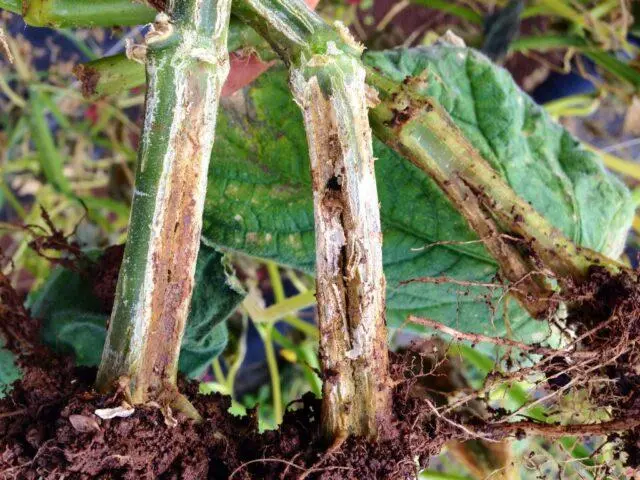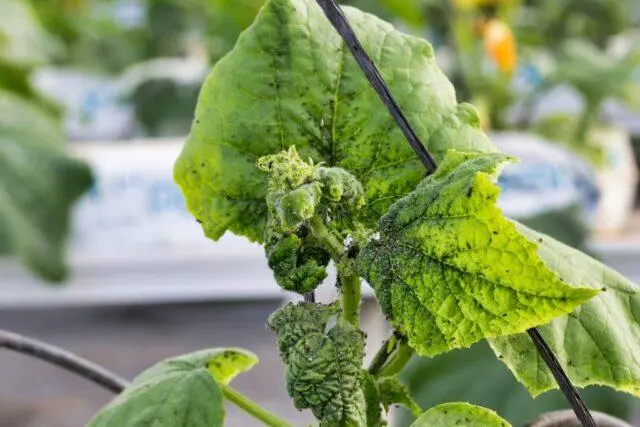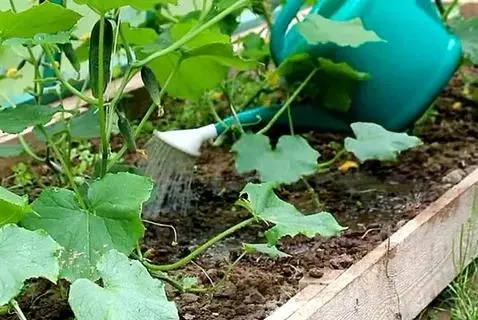Contents
To get fresh vegetables as quickly as possible, gardeners select the earliest varieties that have the shortest period from sowing to the first harvest. This goal is best met by the Harmonist cucumber, an early-ripening hybrid intended for growing indoors.
The story of
Cucumbers Harmonist F1 (Cucumis sativus L) is the result of the work of breeders (Gavrish S., Portyankin A., Shamshina A., Shevku). The variety was obtained in the seed company Gavrish, in 2008 it was included in the State Register and recommended for cultivation in greenhouse conditions in most regions of the country.

Cucumbers Harmonist F1 – hybrid of the first generation
Description of cucumbers Harmonist F1
The shoots of cucumber varieties Harmonist F1 are rough, creeping, form a bush with moderate lateral branching. The length of the stems of the plant is 160-200 cm. In the presence of a vertical support, they cling to it with antennae located at the tops. The leaves are bright green, medium-sized, heart-shaped, five-lobed. Flowers yellow, female. Up to 4-5 ovaries develop in one sinus. The fruits of cucumbers of the Harmonist F1 variety are cylindrical in shape, with small tubercles. At the stage of technical ripeness, their length is 10-13 cm, diameter – 3,5 cm, average weight – about 100 g. The skin is slightly pubescent, dark green, the tips are lighter. Small whitish spots or blurry streaks are acceptable. Fruits of dense structure, without voids.

Pulp of cucumbers of the Harmonist F1 variety of excellent taste without bitterness, with a characteristic aroma
Characteristics of cucumbers Harmonist
The variety belongs to parthenocarpic, i.e. self-pollinating. The type of flowering is female, already during the budding period, ovaries appearing in the sinuses are visible. The level of branching is low. The plant is moisture-loving, does not tolerate drought well. With a lack of moisture, it withers, stops growing. With a long absence of watering, the greens turn yellow and dry out. Cucumbers Harmonist F1 are sensitive to temperature drops, develop slowly if the soil is not warm enough.
Productivity
The yield depends on the stage at which the fruits of the Harmonist F1 variety are harvested. When harvesting cucumbers in technical ripeness, it is 13 kg per m2, in the phase of pickles – 5 kg. The final result depends on the correct preparation of the soil, the absence of thickening of plantings, the regularity of watering, loosening, and ventilation of the greenhouse. It is equally important to carry out top dressing and preventive measures to protect against diseases and pests in time.
Ripening and flowering time
Harmonist F1 is a parthenocarpic hybrid with female flowers that do not require pollination. Cucumber buds form after the foliage and roots of the plant slow down their growth. The variety belongs to early maturing. 30 days after germination, flowering begins and ovaries are formed. The first buds bloom on the main stem, gradually moving to the side of the first and second order. The fruits ripen two weeks after the start of flowering.
Subject to agricultural technology, the fruiting of the plant lasts from 30 to 60 days.

The fruits of cucumber varieties Harmonist F1 do not form seeds
Disease and pest resistance
The hybrid is immune to most diseases, but if agricultural practices are violated, the likelihood of cucumbers being affected by powdery mildew, cladosporiosis, and root rot increases.
Cladosporiosis
Young plants are most often affected by the fungus. It falls on the foliage of Harmonist cucumbers along with water, garden tools, shoes, and insects. A grid of red spots appears on the bushes, which gradually become wet, necrosis develops, and the plant dies. To destroy the fungus at the first signs of the disease, spraying with Bordeaux mixture is carried out.

To prevent cladosporiosis, Harmonist F1 cucumbers are sprayed with a solution of copper oxychloride (0,4%)
Mučnistaâ rosa
The disease can be detected by a white coating on the back of the leaf, later whitish spots grow on the outside. Then the leaf plates darken, twist and dry. As a treatment, spraying with soda solution (0,4%) and Fitosporin is used.

Fruits of cucumbers of the Harmonist variety, affected by powdery mildew, not juicy, have a bitter aftertaste
Root rot
Dark spots appear on the roots of plants, the stem gradually becomes thinner, dries, fades and dies. The cause of the disease is a violation of agricultural technology and irrigation regime. The disease spreads very quickly, therefore, at the first sign, the affected bushes are removed and burned, and the soil is treated with a solution of bleach (150 g per 1 m2).

Watering cucumber varieties Harmonist F1 is reduced to a minimum when the first symptoms of root rot appear.
Insect pests are no less dangerous for plants.
spider mite
Ticks are difficult to see because their size does not exceed 1 mm. Pests are given out by a web enveloping the foliage. If timely treatment with acaricides (Keltan, Phosphamide) or biological products (Bitoxibacillin) is not carried out, the Harmonist cucumbers will die.

The tick sucks the juice from the leaves and weakens the whole plant.
aphid
Pests settle in colonies on the back of the foliage. Hordes of insects infect flowers and ovaries, suck out juice and dehydrate plants. For the destruction of pests, biological products are used (Actofit, Fitoverm), and in advanced cases, insecticides.

The peak of aphid activity on cucumbers is the middle of summer
Advantages and disadvantages
It will take only a month and a half to get the first harvest of Harmonist F1 cucumbers. The early maturity of the variety is not its only advantage. The fruiting of the hybrid Harmonist is plentiful and long.
Pros:
- self-pollination of the variety;
- disease resistance;
- excellent taste without bitterness;
- good transportability;
- high yield;
- universality of application.
There are practically no cons to the variety. The disadvantages of the Harmonist F1 hybrid include the impossibility of collecting and using seeds.
Planting Cucumbers Harmonist
Cucumbers Harmonist F1 can be grown by sowing seeds or using seedlings. In any case, they create a shelter – temporary or permanent. A greenhouse or greenhouse helps to obtain optimal conditions for plants, shorten the ripening period of the crop, and protect against adverse weather.
Sowing in open ground
When choosing a place for planting cucumbers, the Harmonist varieties prefer the south side of the site, protected from drafts and northern winds. It should not be swampy, shading is unacceptable. Ideal predecessors for cucumbers are legumes, wheat, rye, tomatoes or cabbage. For sowing seeds in open ground, it is necessary to prepare the soil. It is dug up, weeds are removed, disinfected, compost, wood ash, potassium sulfate are added. Ridges of medium height should be formed in advance and covered with a film to warm the soil.
Cucumber seeds Harmonist F1 are calibrated, disinfected in a solution of potassium permanganate, hardened, bubbling. Sowing is carried out in grooves 3-4 cm deep. They are laid out with an interval of 20-30 cm and covered with a layer of soil 2 cm thick. A shelter is made of arcs, film or non-woven material above the ridge.

Sowing dates are calculated so that seedlings appear after the threat of frost has passed.
Seedbed method
Cultivation of cucumbers Harmonist F1 from seedlings significantly accelerates their growth, development, fruit formation. Sowing seeds begins in the third decade of April. Containers, plastic or peat cups are used as containers for seedlings. They operate according to the algorithm:
- The containers are filled with the finished soil mixture by two-thirds of the volume.
- Watered with warm settled water.
- A hole 1,5 cm deep is made in the center.
- Place one seed at the bottom.
- Fall asleep with soil.
- Cover with a film and transfer to a warm (+27 ⁰С) place.
After 3-4 days, the seeds of cucumbers Harmonist F1 give the first shoots. The shelter is removed, and the containers are transferred to a cooler (+18 ⁰С) and well-lit place. In the phase of 2-3 true leaves, the seedlings are transplanted into the greenhouse by transshipment or together with a peat glass. The plants are placed at a distance of 50 cm from each other, watered and create a support to which the Harmonist F1 cucumbers will be tied as they grow.

It takes 1-25 days to grow seedlings of the Harmonist F30 variety
Rules for the care of cucumbers Harmonist
Variety Harmonist is very demanding on moisture. It is carried out twice a week, and in hot weather – every other day. Water should be warm, settled.
Feed several times during the season:
- In the flowering phase – infusion of chicken manure, diluted in a ratio of 1:20.
- During the fruiting period – liquid manure (1:20).
- To increase productivity – ammonium nitrate (15 g) and double superphosphate (20 g).
For uniform illumination of cucumbers, they are periodically tied to a trellis. To prevent the bushes from thickening, pinching is carried out – 2-3 lateral shoots are removed. At a height of 1,5 m, pinch the tops of the plants.

Cucumbers of the Harmonist variety are watered in the evening, and in the morning they loosen the soil, remove weeds, mulch the soil surface
Conclusion
Cucumber Harmonist F1 is one of the best options for growing indoors. When all the rules of agricultural technology are followed, fruiting occurs early and lasts until autumn. The variety is not capricious, responds well to care, so even novice gardeners can get an impressive crop of vegetables.









